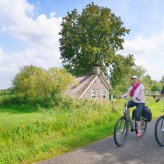Weerribben-Wieden; where the high Netherlands become lowland.
Weerribben-Wieden, on the border of four provinces and several National Parks and Landscape Foundations, is situated in the heart of Dutch cultural history. This is where the historic tales of the Spanish War, the Hanseatic League, the trade routes, the reclamation, and the start of the welfare state all took place. The origins of the Dutch lowlands and life around water are regaled here.
Largest bog in Northwest Europe
Weerribben-Wieden is manmade. With feet in the peat and hands in the reeds. Between the higher plateau of Drenthe in the east and the edge of the dunes in the west, marshes started to form after the Ice Ages. These marshes were partially reclaimed during medieval times. With their bare hands, peat cutters of days gone by and reedland custodians of today shaped – and are still shaping – the present landscape of what is now the largest bog in Northwestern Europe.
Dutch transitions
Weerribben-Wieden is a pearl of the Netherlands. Unprecedented in our country and the rest of the world. Weerribben-Wieden is the glue for a mosaic of cultural history and landscapes. From high to low, from dry to wet, from saltwater to freshwater, from sand to clay and peat. Nowhere else in the Netherlands are these transitions as clearly visible as here. The varying landscapes with their own local characters are all connected.
Nationaal Park & the peat heart;
Giethoorn & the water villages;
Zuyder Zee towns & the trading towns en;
Steenwijk & the high land.




